 The Two Micron All Sky Survey at IPAC
The Two Micron All Sky Survey at IPAC
![]()
 The Two Micron All Sky Survey at IPAC
The Two Micron All Sky Survey at IPAC
|
|
|
 One of our Greatest Hits!
One of our Greatest Hits!
The Orion Nebula, or Messier 42, is a H II region excited by stars in
the Trapezium Cluster, the dense concentration of bright, hot stars near the
center of the image. In total, the Trapezium and the associated cluster
contains more than three thousand stars. The Nebula itself is a
gaseous bubble formed on the front side of the Orion A Molecular Cloud. The
bright, extended nebulosity seen in this image can be attributed to scattered
starlight from dust in the nebula, various hydrogen emission lines, and
shocked molecular hydrogen at 2 microns. To the north of the Orion Nebula is
the OMC-2 molecular cloud and a series of red stars signifying young, embedded
protostellar objects.
Note also the bipolar nebula in this region. Finally, at the top of the image
is the H II region NGC 1977. This nebula is much brighter at optical
wavelengths, although faint wisps of nebulosity are apparent in this image.
The right-most object among the pair of bright blue stars is the ionizing
source for NGC 1977.
The star forming regions shown in the figure are just a few of the many
embedded star-forming sites in the Orion Molecular Cloud. At a distance of 450
pc (1470 light years), this cloud represents the closest site of high mass
star formation to the sun, and therefore provides a unique laboratory for
studies by astronomers at many wavelengths.
This image required only 10 minutes of 2MASS observation time.
Mosaic image construction by E. Kopan (IPAC).
Featured as an
Astronomy Picture of the Day!
(Field size 0.81° × 1.19°. Image size 2.80 MB!)
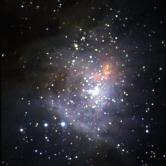 High contrast view of the Trapezium Region of the Orion Nebula.
The Trapezium is the young, massive stars near the center of the image, and in
conjunction with the thousands of other stars seen in this image, constitute
the Orion Nebula Cluster. With a central stellar density of 2 ×
104 stars pc-3 (Hillenbrand & Hartmann 1998, ApJ, 492,
540), the Orion Nebula Cluster is the richest, densest concentration of young
stars in the solar neighborhood. The small group of red stars just northwest
of the Trapezium is the famous BN-KL complex. These objects appear red because
they remain embedded in the OMC-1 molecular cloud, located just behind the
Trapezium. Also seen in this image is the Orion Bar photodissociation region,
which is signified by the abrupt
halt in the nebular emission toward the southwest portion of the image.
High contrast view of the Trapezium Region of the Orion Nebula.
The Trapezium is the young, massive stars near the center of the image, and in
conjunction with the thousands of other stars seen in this image, constitute
the Orion Nebula Cluster. With a central stellar density of 2 ×
104 stars pc-3 (Hillenbrand & Hartmann 1998, ApJ, 492,
540), the Orion Nebula Cluster is the richest, densest concentration of young
stars in the solar neighborhood. The small group of red stars just northwest
of the Trapezium is the famous BN-KL complex. These objects appear red because
they remain embedded in the OMC-1 molecular cloud, located just behind the
Trapezium. Also seen in this image is the Orion Bar photodissociation region,
which is signified by the abrupt
halt in the nebular emission toward the southwest portion of the image.
(Field size 12.8´ × 8.5´. Image size 249 kB.)
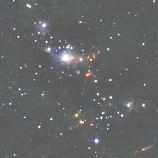
The star formation region NGC 1333. Image mosaic by E. Kopan (IPAC).
(Field size 14.5´ × 14.5´. Image size 830 kB.)
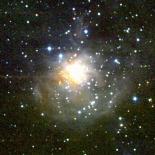 The Galactic H II region and reflection nebula NGC 1579, illuminated
by the unusual emission-line star LkH
The Galactic H II region and reflection nebula NGC 1579, illuminated
by the unusual emission-line star LkH 101, a Herbig Ae/Be star,
the high stellar mass analogs to the low mass, pre-main sequence stars, such as T Tauri
(below). The cluster of objects surrounding LkH
101, a Herbig Ae/Be star,
the high stellar mass analogs to the low mass, pre-main sequence stars, such as T Tauri
(below). The cluster of objects surrounding LkH 101 are
lower-mass stars forming in the same molecular cloud.
101 are
lower-mass stars forming in the same molecular cloud.
(Field size 13.8´ × 10.4´. Image size 427 kB.)
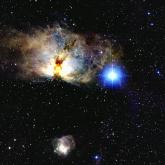 NGC 2024, also known as the Flame Nebula, is located
at a distance of 400-500 pc and is part of the
Orion Molecular Cloud Complex (Orion B). See Meyer &
Lada (1999, The Orion Complex Revisited, ASP Conference
Series, in press) and references therein for an overview
of the region. To the south
of the NGC 2024 region lies NGC 2023 (a well-studied
photo-dissociation region) and the Horsehead Nebula
(cf. David Malin's
optical image). At near-infrared
wavelengths, a dense stellar cluster is revealed in the
dark lane separating the two halves of the flame.
The age of the cluster is thought to be <1 Myr and the
distribution of stellar masses appears to be consistent
with that characterizing the solar neighborhood.
Between 40-70% of the stars in this cluster are
surrounded by circumstellar accretion disks, commonly
associated with young stellar objects. Such disks may
be sites of planet formation and could give rise to solar
systems not unlike our own.
NGC 2024, also known as the Flame Nebula, is located
at a distance of 400-500 pc and is part of the
Orion Molecular Cloud Complex (Orion B). See Meyer &
Lada (1999, The Orion Complex Revisited, ASP Conference
Series, in press) and references therein for an overview
of the region. To the south
of the NGC 2024 region lies NGC 2023 (a well-studied
photo-dissociation region) and the Horsehead Nebula
(cf. David Malin's
optical image). At near-infrared
wavelengths, a dense stellar cluster is revealed in the
dark lane separating the two halves of the flame.
The age of the cluster is thought to be <1 Myr and the
distribution of stellar masses appears to be consistent
with that characterizing the solar neighborhood.
Between 40-70% of the stars in this cluster are
surrounded by circumstellar accretion disks, commonly
associated with young stellar objects. Such disks may
be sites of planet formation and could give rise to solar
systems not unlike our own.
Image mosaic by E. Kopan and R. Hurt (IPAC).
Caption provided by M. Meyer (Steward Obs, U of A).
(Field size 0.73° × 1.03°. Image size 645 kB.)
Find a "movie" of the optical versus 2MASS view of the Horsehead
Nebula, near NGC 2024,
here.
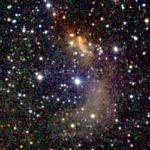 Atlas Image mosaic of NGC 2626, which, at a distance of about 1 kpc
(3300 light years), is
primarily reflecting the light from the bright blue (B1-type) 10th-magnitude
star, CD -40°4432, which is embedded in it. (The star is seen toward the
center of, and appears to be blended with another star in, the 2MASS image.)
The infrared-bright jet-like nebula seen north of the blue star is the
Herbig-Haro object HH 132, emanating from the bright infrared source
IRAS 08337-4028. The bright star east and a bit north of CD -40°4432 is
the pulsating variable star EM Velorum, a possible intermediate-mass Herbig
Ae star. (The bright star at the top of the 2MASS image is IRAS 08338-4022.)
Mueller & Graham (2000, PASP, 112, 1426), based on optical narrow-line imaging,
have identified a number of H
Atlas Image mosaic of NGC 2626, which, at a distance of about 1 kpc
(3300 light years), is
primarily reflecting the light from the bright blue (B1-type) 10th-magnitude
star, CD -40°4432, which is embedded in it. (The star is seen toward the
center of, and appears to be blended with another star in, the 2MASS image.)
The infrared-bright jet-like nebula seen north of the blue star is the
Herbig-Haro object HH 132, emanating from the bright infrared source
IRAS 08337-4028. The bright star east and a bit north of CD -40°4432 is
the pulsating variable star EM Velorum, a possible intermediate-mass Herbig
Ae star. (The bright star at the top of the 2MASS image is IRAS 08338-4022.)
Mueller & Graham (2000, PASP, 112, 1426), based on optical narrow-line imaging,
have identified a number of H -bright sources in the field,
which they associate with lower-mass, young K-type dwarfs, some of which may be
T Tauri stars. IRAS 08337-4028 is most
likely an embedded forming star, but the 2MASS image reveals a number of other
young stellar objects as well, embedded in the dark cloud immediately north of
NGC 2626 and elsewhere in the reflection nebula. Image mosaic by S. Van Dyk
(IPAC). (Field size 12.0´ × 12.0´. Image size 573 kB.)
-bright sources in the field,
which they associate with lower-mass, young K-type dwarfs, some of which may be
T Tauri stars. IRAS 08337-4028 is most
likely an embedded forming star, but the 2MASS image reveals a number of other
young stellar objects as well, embedded in the dark cloud immediately north of
NGC 2626 and elsewhere in the reflection nebula. Image mosaic by S. Van Dyk
(IPAC). (Field size 12.0´ × 12.0´. Image size 573 kB.)
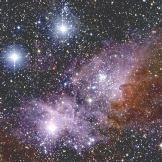 Atlas Image mosaic of the Carina (Keyhole) Nebula.
This spectacular region of the Milky Way Galaxy, also known as NGC 3372,
contains an unusually high concentration of young massive stars, many
located in star clusters, at about 2300 pc (7500 light years). The region is
the result of a burst of star
formation ~3 Myr ago. Star formation in this region is still ongoing!
The truly phenomenal star
Atlas Image mosaic of the Carina (Keyhole) Nebula.
This spectacular region of the Milky Way Galaxy, also known as NGC 3372,
contains an unusually high concentration of young massive stars, many
located in star clusters, at about 2300 pc (7500 light years). The region is
the result of a burst of star
formation ~3 Myr ago. Star formation in this region is still ongoing!
The truly phenomenal star  Carinae,
a luminous blue variable star which experienced an enormous outburst in 1843,
is the bright star toward the southeast of the nebula. This star,
seen surrounded by the amazing double-lobed structure of the Homunculus at
high spatial resolution by the
Hubble Space
Telescope, is one of the most massive stars in the Galaxy, at over 100
times the mass of the Sun (Davidson & Humphreys 1997, ARA&A, 35, 1).
(
Carinae,
a luminous blue variable star which experienced an enormous outburst in 1843,
is the bright star toward the southeast of the nebula. This star,
seen surrounded by the amazing double-lobed structure of the Homunculus at
high spatial resolution by the
Hubble Space
Telescope, is one of the most massive stars in the Galaxy, at over 100
times the mass of the Sun (Davidson & Humphreys 1997, ARA&A, 35, 1).
(  Car in the 2MASS image shows a persistence artifact that
trails due north of the star; the artifact shows this known double-lobed
structure of the Homonculus as well.)
Car in the 2MASS image shows a persistence artifact that
trails due north of the star; the artifact shows this known double-lobed
structure of the Homonculus as well.)
 Car is part of star cluster Trumpler 16. Another very
rich cluster of massive stars is Trumpler 14, in the nebula toward the
northwest. The nebula, as seen by 2MASS, is a complex mixture of molecular
gas, reflected starlight, and dust. Within the large dark patches and
tendrils of dust are new, obscured young stars still forming in this large
cloud. N.B.: The full mosaic is a very large file:
6.6 Mb! Image mosaic by E. Kopan (IPAC). (Field size 0.70° × 0.90°. Image size 6.6 Mb!)
Featured as an
Astronomy Picture of the Day!
Car is part of star cluster Trumpler 16. Another very
rich cluster of massive stars is Trumpler 14, in the nebula toward the
northwest. The nebula, as seen by 2MASS, is a complex mixture of molecular
gas, reflected starlight, and dust. Within the large dark patches and
tendrils of dust are new, obscured young stars still forming in this large
cloud. N.B.: The full mosaic is a very large file:
6.6 Mb! Image mosaic by E. Kopan (IPAC). (Field size 0.70° × 0.90°. Image size 6.6 Mb!)
Featured as an
Astronomy Picture of the Day!
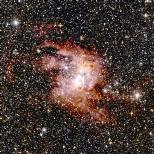 Atlas Image mosaic of NGC 3603.
(The mosaic has been binned to 2´´ pixels.) This nebula is the
largest HII (ionized hydrogen) region in
the Milky Way Galaxy and is considered a giant HII region, in the same class
of objects as 30 Doradus in the Large Magellanic
Cloud.
(Many spiral galaxies have large numbers of these giant HII regions; the
Milky Way has very few.) NGC 3603 is along the Carina spiral arm of the
Galaxy, at a distance of about 6000-7000 pc (20000-23000 light years) from us.
The nebula is ionized by an enormous cluster of hot, young, massive stars
(seen shining brightly toward the center of the 2MASS image); this bright core
of stars resembles the truly spectacular stellar cluster, R136, which is the
source of ionization for 30 Dor. Brandl et al. (1999, A&A, 352, L69) recently
imaged the central cluster
in the near-infrared with ESO's Very Large Telescope; their star-for-star
analysis reveals pre-main sequence stars and low-mass main sequence
stars, with ages of less than 1 million years, which shows for the first time
that sub-solar mass stars do form along with the most massive stars in
such giant starbursts. Image mosaic by E. Kopan (IPAC).
(Field size 28.4´ × 36.6´. Image size 1.1 Mb!)
Atlas Image mosaic of NGC 3603.
(The mosaic has been binned to 2´´ pixels.) This nebula is the
largest HII (ionized hydrogen) region in
the Milky Way Galaxy and is considered a giant HII region, in the same class
of objects as 30 Doradus in the Large Magellanic
Cloud.
(Many spiral galaxies have large numbers of these giant HII regions; the
Milky Way has very few.) NGC 3603 is along the Carina spiral arm of the
Galaxy, at a distance of about 6000-7000 pc (20000-23000 light years) from us.
The nebula is ionized by an enormous cluster of hot, young, massive stars
(seen shining brightly toward the center of the 2MASS image); this bright core
of stars resembles the truly spectacular stellar cluster, R136, which is the
source of ionization for 30 Dor. Brandl et al. (1999, A&A, 352, L69) recently
imaged the central cluster
in the near-infrared with ESO's Very Large Telescope; their star-for-star
analysis reveals pre-main sequence stars and low-mass main sequence
stars, with ages of less than 1 million years, which shows for the first time
that sub-solar mass stars do form along with the most massive stars in
such giant starbursts. Image mosaic by E. Kopan (IPAC).
(Field size 28.4´ × 36.6´. Image size 1.1 Mb!)
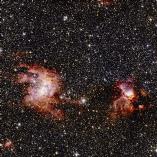 Atlas Image mosaic of
NGC 3603 (left) and NGC 3576
(right). (The mosaic has been binned to 2´´ pixels.)
Both nebulae (referred to together as RCW 57) are
among the largest HII (ionized hydrogen) regions in the Galaxy. Both contain
large numbers of hot, young,
massive stars. Though only about 30´ apart on the sky, NGC 3603 is
about twice as far away from us as NGC 3576 (which is at a distance of about
3000 pc, or 9800 light years). Both HII regions are ideal laboratories for
studying star formation over a broad mass scale in a number of wavelength
regimes. Both regions are partially obscured by foreground dust in the Galaxy,
and both possess a considerable amount of internal dust (as can particularly
be seen for NGC 3576, much like Messier 17),
so studying them in the near-infrared, which penetrates the dust, gives us a
more complete census of both young low-mass and high-mass stars and a more
complete picture of the spatial distribution of recent star formation. In
the optical, NGC 3576 shows bright extended loop-like nebulosity to the
northeast, which is not seen in the 2MASS image. Image mosaic by E. Kopan
(IPAC). (Field size 57.4´ × 48.2´. Image size 3.0 Mb!)
Atlas Image mosaic of
NGC 3603 (left) and NGC 3576
(right). (The mosaic has been binned to 2´´ pixels.)
Both nebulae (referred to together as RCW 57) are
among the largest HII (ionized hydrogen) regions in the Galaxy. Both contain
large numbers of hot, young,
massive stars. Though only about 30´ apart on the sky, NGC 3603 is
about twice as far away from us as NGC 3576 (which is at a distance of about
3000 pc, or 9800 light years). Both HII regions are ideal laboratories for
studying star formation over a broad mass scale in a number of wavelength
regimes. Both regions are partially obscured by foreground dust in the Galaxy,
and both possess a considerable amount of internal dust (as can particularly
be seen for NGC 3576, much like Messier 17),
so studying them in the near-infrared, which penetrates the dust, gives us a
more complete census of both young low-mass and high-mass stars and a more
complete picture of the spatial distribution of recent star formation. In
the optical, NGC 3576 shows bright extended loop-like nebulosity to the
northeast, which is not seen in the 2MASS image. Image mosaic by E. Kopan
(IPAC). (Field size 57.4´ × 48.2´. Image size 3.0 Mb!)
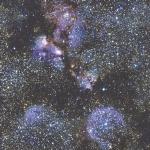 Atlas Image mosaic of the Cat's Paw, or Bear Claw,
Nebula, aka NGC 6334. Image mosaic by S. Van Dyk (IPAC).
(Field size 42´ × 42´. Image size 5.6 Mb!)
Atlas Image mosaic of the Cat's Paw, or Bear Claw,
Nebula, aka NGC 6334. Image mosaic by S. Van Dyk (IPAC).
(Field size 42´ × 42´. Image size 5.6 Mb!)
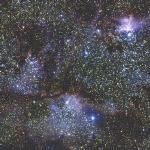 Atlas Image mosaic of the War and Peace
Nebula, aka NGC 6357. The nebula attained this colloquial name, due
to its
appearance in the mid-infrared, as seen by the
Midcourse Space Experiment (MSX)
scientists. They see the bright portion of the nebula, to the northwest, as
looking like a dove, while the mid-IR filaments to the east seem to trace out
a human skull.
The "dove" is still seen in the 2MASS near-infrared image, but the "skull" is
not nearly as apparent as in the MSX image. As can be seen in
a much larger mosaic, NGC 6357 (to the north) and
NGC 6334 (to the south) are located not far from
each other, along the Galactic plane, just south and west of the
Galactic center. (N.B.: The full NGC 6357
mosaic is 4.9 Mb in size.) Image mosaic by S. Van Dyk (IPAC). (Larger NGC
6334/6357 mosaic by E. Kopan & R. Hurt, IPAC.)
(Field size 40´ × 40´. Image size 4.9 Mb!)
Atlas Image mosaic of the War and Peace
Nebula, aka NGC 6357. The nebula attained this colloquial name, due
to its
appearance in the mid-infrared, as seen by the
Midcourse Space Experiment (MSX)
scientists. They see the bright portion of the nebula, to the northwest, as
looking like a dove, while the mid-IR filaments to the east seem to trace out
a human skull.
The "dove" is still seen in the 2MASS near-infrared image, but the "skull" is
not nearly as apparent as in the MSX image. As can be seen in
a much larger mosaic, NGC 6357 (to the north) and
NGC 6334 (to the south) are located not far from
each other, along the Galactic plane, just south and west of the
Galactic center. (N.B.: The full NGC 6357
mosaic is 4.9 Mb in size.) Image mosaic by S. Van Dyk (IPAC). (Larger NGC
6334/6357 mosaic by E. Kopan & R. Hurt, IPAC.)
(Field size 40´ × 40´. Image size 4.9 Mb!)
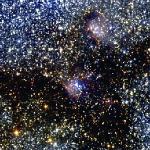 Atlas Image mosaic of the open star cluster,
reflection nebula, and HII (or ionized hydrogen) region complex
NGC 6595, aka Sharpless 37, which is part of the much larger
Sagittarius Star Cloud, Messier 24. The complex is
associated with a portion of a dark cloud of dust and molecular gas. The
early B-type star, HD 313095 (the brightest blue star, among the small cluster
of blue stars, in the region), is likely
responsible for most of the ultraviolet photons ionizing Sharpless 37. The
cloud, at a distance of about 1.8 kpc (about 5900 light years), is actually
quite large and has been recently mapped out in the radio by Saito et al.
(1999, PASJ, 51, 819). The cloud, containing about one hundred thousand solar
masses of molecular gas, is an active site of massive star formation. Saito
et al. conclude that a hole in the neutral hydrogen gas distribution, adjacent
to the molecular cloud to the west, may be part of a supershell of gas,
created by the action of several supernovae which exploded over the last few
million years. It is possible that pressure from this supershell is
responsible for the current active star formation.
Image mosaic by S. Van Dyk (IPAC).
(Field size 15.4´ × 13.6´. Image size 811 kb.)
Atlas Image mosaic of the open star cluster,
reflection nebula, and HII (or ionized hydrogen) region complex
NGC 6595, aka Sharpless 37, which is part of the much larger
Sagittarius Star Cloud, Messier 24. The complex is
associated with a portion of a dark cloud of dust and molecular gas. The
early B-type star, HD 313095 (the brightest blue star, among the small cluster
of blue stars, in the region), is likely
responsible for most of the ultraviolet photons ionizing Sharpless 37. The
cloud, at a distance of about 1.8 kpc (about 5900 light years), is actually
quite large and has been recently mapped out in the radio by Saito et al.
(1999, PASJ, 51, 819). The cloud, containing about one hundred thousand solar
masses of molecular gas, is an active site of massive star formation. Saito
et al. conclude that a hole in the neutral hydrogen gas distribution, adjacent
to the molecular cloud to the west, may be part of a supershell of gas,
created by the action of several supernovae which exploded over the last few
million years. It is possible that pressure from this supershell is
responsible for the current active star formation.
Image mosaic by S. Van Dyk (IPAC).
(Field size 15.4´ × 13.6´. Image size 811 kb.)
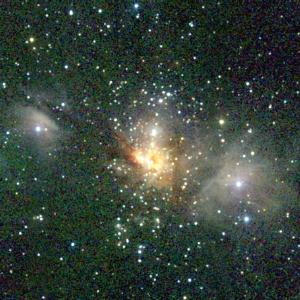 The molecular cloud and embedded star cluster Monoceros R2.
The 2MASS image of a stellar cluster in the Mon R2 chain of reflection nebulae.
At a distance of 830 pc (2700 light years), the Mon R2 cluster is one of the
closest massive star-forming regions to the Sun that remains embedded in a
molecular cloud. The cluster contains at least a few hundred pre-main sequence
stars within a 0.4-pc diameter region, and likely has formed within the past
few million years (Carpenter et al. 1997, AJ, 114, 198). The two blue patches
of luminosity on either side of the Mon R2 cluster are illuminated by early
B-type stars, and are part of a chain of about 30 such reflection nebulae that
define the Mon R2 association (Herbst & Racine 1976, AJ, 81, 840). (Field
size 12.5´ × 20.8´. Image size 955 kB.)
The molecular cloud and embedded star cluster Monoceros R2.
The 2MASS image of a stellar cluster in the Mon R2 chain of reflection nebulae.
At a distance of 830 pc (2700 light years), the Mon R2 cluster is one of the
closest massive star-forming regions to the Sun that remains embedded in a
molecular cloud. The cluster contains at least a few hundred pre-main sequence
stars within a 0.4-pc diameter region, and likely has formed within the past
few million years (Carpenter et al. 1997, AJ, 114, 198). The two blue patches
of luminosity on either side of the Mon R2 cluster are illuminated by early
B-type stars, and are part of a chain of about 30 such reflection nebulae that
define the Mon R2 association (Herbst & Racine 1976, AJ, 81, 840). (Field
size 12.5´ × 20.8´. Image size 955 kB.)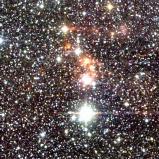 The high-mass star formation region K3-50.
The red nebular region directly above the brightest star in this
three-color composite image is the high mass star formation complex known as
K3-50. The cluster is
located in the constellation Cygnus at a distance of about 8700 pc (28000
light years). The region is quite young. While the Sun is presently about 5
billion years old, this cluster is only around 10 to 100 thousand years
old. Stars are generally considered massive if they are 10 times the mass
of the Sun or larger. In the case of this complex good evidence exists
that at least three of the stars are larger than 60 times the mass of the Sun
(Howard et al. 1996, ApJ, 460, 744). In addition to these stars, at
least four other massive stars are present in this region. High mass stars
typically form in complex clusters, and this region is no exception. K3-50
is comprised of at least five different regions of high mass star formation.
The southernmost region is visible at optical wavelengths and is one of
the more evolved regions in the complex. Progressing northward, the regions of
star formation are located deeper in the parent molecular cloud. Most of
the nebular emission seen here is only detectable by observing in
near-infrared, or even longer, wavelengths.
The high-mass star formation region K3-50.
The red nebular region directly above the brightest star in this
three-color composite image is the high mass star formation complex known as
K3-50. The cluster is
located in the constellation Cygnus at a distance of about 8700 pc (28000
light years). The region is quite young. While the Sun is presently about 5
billion years old, this cluster is only around 10 to 100 thousand years
old. Stars are generally considered massive if they are 10 times the mass
of the Sun or larger. In the case of this complex good evidence exists
that at least three of the stars are larger than 60 times the mass of the Sun
(Howard et al. 1996, ApJ, 460, 744). In addition to these stars, at
least four other massive stars are present in this region. High mass stars
typically form in complex clusters, and this region is no exception. K3-50
is comprised of at least five different regions of high mass star formation.
The southernmost region is visible at optical wavelengths and is one of
the more evolved regions in the complex. Progressing northward, the regions of
star formation are located deeper in the parent molecular cloud. Most of
the nebular emission seen here is only detectable by observing in
near-infrared, or even longer, wavelengths.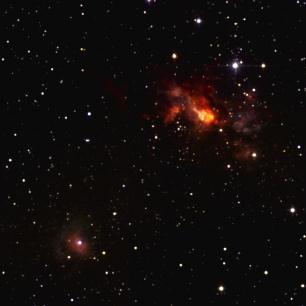 An image mosaic of the star formation complex and
young stellar outflow Cepheus A, at 725 pc (2400 light years) distant. The
infrared bright core of the radio source Cepheus A, to the northwest in the
mosaic, contains a number of highly obscured young, massive stars and
molecular gas. A complex molecular outflow extends from the core. The core
itself is obscured by more than 100 magnitudes of optical extinction!
Reflection nebulae, bright Herbig-Haro objects, bow shocks, and jets are also
seen in the complex (Hartigan et al. 1996, AJ, 111, 1278). The bright nebula
to the southeast in the mosaic is IRAS 22551+6139, also a probable young
stellar object. These data are part of the Spring 1999 data release.
Image mosaic by R. Cutri (IPAC). (Field size 14.2´ × 14.2´.
Image size 438 kB.)
An image mosaic of the star formation complex and
young stellar outflow Cepheus A, at 725 pc (2400 light years) distant. The
infrared bright core of the radio source Cepheus A, to the northwest in the
mosaic, contains a number of highly obscured young, massive stars and
molecular gas. A complex molecular outflow extends from the core. The core
itself is obscured by more than 100 magnitudes of optical extinction!
Reflection nebulae, bright Herbig-Haro objects, bow shocks, and jets are also
seen in the complex (Hartigan et al. 1996, AJ, 111, 1278). The bright nebula
to the southeast in the mosaic is IRAS 22551+6139, also a probable young
stellar object. These data are part of the Spring 1999 data release.
Image mosaic by R. Cutri (IPAC). (Field size 14.2´ × 14.2´.
Image size 438 kB.)
 Messier 8: The Lagoon Nebula.
The red emission in the optical image is from hydrogen, after recombination, in
this famous H II region. Note the absence of the nebular hydrogen emission in
the 2MASS image. The Hourglass Nebula is clearly visible, near the
center of the optical nebulosity of the Lagoon,
at a distance of about 1.5 kpc along the Sagittarius/Carina
arm of the Galaxy. The Hourglass itself is mainly ionized by the O7V star
Herschel 36 (White et al. 1997, A&A, 323, 529); the
more extended nebulosity is ionized by the O stars HD 165052 and 9 Sgr
(Woolf 1961, PASP, 73, 206).
Numerous compact infrared sources are along the line of sight to the core of
the Hourglass. Woodward et al. (1990, ApJ, 365, 252) previously imaged the
Hourglass in the near-IR and found that two sources are consistent with the
colors of early B stars, while a third may be a pre-main sequence object. A
lack of near-IR H2 emission indicates that molecular outflow
activity is much less prominent than in many active star-forming regions
(White et al. 1997).
Image mosaic by E. Kopan (IPAC). (Field size 17.1´ × 17.1´.
Image size 652 kB.)
Messier 8: The Lagoon Nebula.
The red emission in the optical image is from hydrogen, after recombination, in
this famous H II region. Note the absence of the nebular hydrogen emission in
the 2MASS image. The Hourglass Nebula is clearly visible, near the
center of the optical nebulosity of the Lagoon,
at a distance of about 1.5 kpc along the Sagittarius/Carina
arm of the Galaxy. The Hourglass itself is mainly ionized by the O7V star
Herschel 36 (White et al. 1997, A&A, 323, 529); the
more extended nebulosity is ionized by the O stars HD 165052 and 9 Sgr
(Woolf 1961, PASP, 73, 206).
Numerous compact infrared sources are along the line of sight to the core of
the Hourglass. Woodward et al. (1990, ApJ, 365, 252) previously imaged the
Hourglass in the near-IR and found that two sources are consistent with the
colors of early B stars, while a third may be a pre-main sequence object. A
lack of near-IR H2 emission indicates that molecular outflow
activity is much less prominent than in many active star-forming regions
(White et al. 1997).
Image mosaic by E. Kopan (IPAC). (Field size 17.1´ × 17.1´.
Image size 652 kB.)
 Atlas Image mosaic of Messier 16 (M16), the Eagle Nebula.
Image mosaic by S. Van Dyk (IPAC).
(Field size 15.5´ × 15.5´. Image size 970 kb.)
Atlas Image mosaic of Messier 16 (M16), the Eagle Nebula.
Image mosaic by S. Van Dyk (IPAC).
(Field size 15.5´ × 15.5´. Image size 970 kb.)
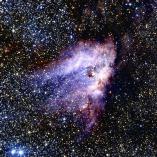 Atlas Image mosaic of Messier 17 (M17), aka the Omega
Nebula, the Swan Nebula, the Horseshoe Nebula, and the Lobster Nebula, located
in the constellation Sagittarius. It is roughly 5,000 light years from the Sun.
The 2MASS image penetrates the obscuring veil of dust and reveal the otherwise
invisible contents of a dark molecular cloud. The giant
molecular cloud associated with M17 is one of the most luminous and active
star-forming complexes in the Milky Way, and contains one of the youngest and
richest stellar clusters in our galaxy. Although the gas in the molecular cloud
is too cold to emit visible or near-infrared light, traces of the densest
portions of the cloud can still be seen as dark, obscuring, cloudy structures
in the 2MASS mosaic, by E. Kopan (IPAC).
(Field size 1° × 1°. Image size 12.7 Mb!!)
Atlas Image mosaic of Messier 17 (M17), aka the Omega
Nebula, the Swan Nebula, the Horseshoe Nebula, and the Lobster Nebula, located
in the constellation Sagittarius. It is roughly 5,000 light years from the Sun.
The 2MASS image penetrates the obscuring veil of dust and reveal the otherwise
invisible contents of a dark molecular cloud. The giant
molecular cloud associated with M17 is one of the most luminous and active
star-forming complexes in the Milky Way, and contains one of the youngest and
richest stellar clusters in our galaxy. Although the gas in the molecular cloud
is too cold to emit visible or near-infrared light, traces of the densest
portions of the cloud can still be seen as dark, obscuring, cloudy structures
in the 2MASS mosaic, by E. Kopan (IPAC).
(Field size 1° × 1°. Image size 12.7 Mb!!) The Trifid Nebula, also known as Messier 20, is only about 1.5 degrees
northwest on the sky of the larger Lagoon Nebula, in the constellation
Sagittarius. The Trifid, at a distance of about 2 kiloparsecs (or
6520 light years) gets its name
from its optical appearance, from three dark dust lanes that divide it.
Like the Lagoon, much of the optical emission is dominated by the red light
from hydrogen, forming an "H II region" around the bright small cluster of
stars in the south. Optically, the remainder of the emission is a blue
reflection nebula around the bluer of the two bright stars to the north.
In the near infrared we can see through much of the obscuring dust in the
Trifid, including the name-giving dust lanes. Many more stars can be seen
associated with the nebula in this region near the plane of our Milky Way
Galaxy. (Field size 14.8´ × 20.0´. Image size 1.20 MB!)
The Trifid Nebula, also known as Messier 20, is only about 1.5 degrees
northwest on the sky of the larger Lagoon Nebula, in the constellation
Sagittarius. The Trifid, at a distance of about 2 kiloparsecs (or
6520 light years) gets its name
from its optical appearance, from three dark dust lanes that divide it.
Like the Lagoon, much of the optical emission is dominated by the red light
from hydrogen, forming an "H II region" around the bright small cluster of
stars in the south. Optically, the remainder of the emission is a blue
reflection nebula around the bluer of the two bright stars to the north.
In the near infrared we can see through much of the obscuring dust in the
Trifid, including the name-giving dust lanes. Many more stars can be seen
associated with the nebula in this region near the plane of our Milky Way
Galaxy. (Field size 14.8´ × 20.0´. Image size 1.20 MB!)
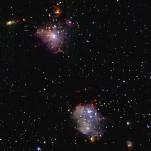 Atlas Image mosaic of the
reflection nebulae NGC 2068 and 2071, comprising Messier 78 (M78).
This complex is located in the LDN 1630 (Orion B)
cloud, at a distance of about 400 pc (1300 light years).
Reflection nebulae, particularly in the optical, are dusty regions
that scatter and reflect the light from typically bright, hot, blue stars
within the regions. They are commonly associated with molecular clouds and
the dusty sites of active star formation.
The illuminating stars for NGC 2068 (to the south) are
HDE 38563A and 38563B, while the illuminating star for NGC 2071 (to the north)
is HDE 290861. The two nebulae appear to contain small clusters of stars.
A number of embedded, young stellar objects are located
throughout this region, highlighted by the large number of dramatic Herbig-Haro
outflow sources; Zhao et al. (1999, AJ, 118, 1347) brought the complement of
HH objects in M78 to 17. Lada et al. (1991, ApJ, 371, 171) conducted a 2.2
µm survey of L1630, complete to K<13 (the 2MASS data go deeper than
this), and concluded that much of the young, embedded star formation is
occurring in clusters. Image mosaic by S. Van Dyk (IPAC).
These data are included in the Second Incremental Release!
(Field size 33.3´ × 46.1´. Image size 4.5 Mb!)
Atlas Image mosaic of the
reflection nebulae NGC 2068 and 2071, comprising Messier 78 (M78).
This complex is located in the LDN 1630 (Orion B)
cloud, at a distance of about 400 pc (1300 light years).
Reflection nebulae, particularly in the optical, are dusty regions
that scatter and reflect the light from typically bright, hot, blue stars
within the regions. They are commonly associated with molecular clouds and
the dusty sites of active star formation.
The illuminating stars for NGC 2068 (to the south) are
HDE 38563A and 38563B, while the illuminating star for NGC 2071 (to the north)
is HDE 290861. The two nebulae appear to contain small clusters of stars.
A number of embedded, young stellar objects are located
throughout this region, highlighted by the large number of dramatic Herbig-Haro
outflow sources; Zhao et al. (1999, AJ, 118, 1347) brought the complement of
HH objects in M78 to 17. Lada et al. (1991, ApJ, 371, 171) conducted a 2.2
µm survey of L1630, complete to K<13 (the 2MASS data go deeper than
this), and concluded that much of the young, embedded star formation is
occurring in clusters. Image mosaic by S. Van Dyk (IPAC).
These data are included in the Second Incremental Release!
(Field size 33.3´ × 46.1´. Image size 4.5 Mb!)
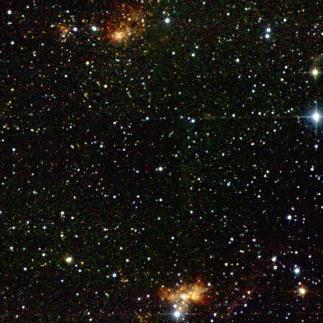 Atlas Image mosaic showing the infrared sources RAFGL 5180 and 5182
(IRAS 06058+2138 and 06061+2151,
respectively). These are both embedded dense clusters of massive young stars
in the Gemini OB1 molecular cloud complex (Carpenter, Snell, & Schloerb 1995,
ApJ, 450, 201), near the HII region Sharpless 247. These data are part of the
Spring 1999 data release. Image mosaic by S. Van Dyk (IPAC).
(Field size 15.0´ × 15.0´. Image size 1.00 MB!)
Atlas Image mosaic showing the infrared sources RAFGL 5180 and 5182
(IRAS 06058+2138 and 06061+2151,
respectively). These are both embedded dense clusters of massive young stars
in the Gemini OB1 molecular cloud complex (Carpenter, Snell, & Schloerb 1995,
ApJ, 450, 201), near the HII region Sharpless 247. These data are part of the
Spring 1999 data release. Image mosaic by S. Van Dyk (IPAC).
(Field size 15.0´ × 15.0´. Image size 1.00 MB!)
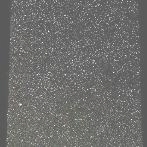 The North American Nebula. This image is centered at 20h
54m +45°. The standard Atlas Image data were resampled in 5´´
pixels to generate this very large map.
The patches of decreased star counts scattered throughout the image are
silhouettes of molecular clouds against the backdrop of field stars in the
Galactic Plane. Observed within these clouds are several extremely red,
embedded stellar clusters surrounded by nebulosity that harbor recently
formed stars. The bright nebulosity that characterizes visible light images
of the nebula arises from both optical emission lines and
light reflected off dust grains in the region. Because emission lines are
generally weaker in the infrared, and dust grains do not scatter infrared
light very efficiently, the diffuse nebulosity is not visible in the 2MASS
image. 2MASS's ability to peer into molecular clouds and lower sensitivity
to diffuse emission make the survey a powerful probe of the stellar content
and structure of the Milky Way. Mosaic image construction by E. Kopan (IPAC).
(Field size 4.2° × 6.2°. Image size 472 kB.)
The North American Nebula. This image is centered at 20h
54m +45°. The standard Atlas Image data were resampled in 5´´
pixels to generate this very large map.
The patches of decreased star counts scattered throughout the image are
silhouettes of molecular clouds against the backdrop of field stars in the
Galactic Plane. Observed within these clouds are several extremely red,
embedded stellar clusters surrounded by nebulosity that harbor recently
formed stars. The bright nebulosity that characterizes visible light images
of the nebula arises from both optical emission lines and
light reflected off dust grains in the region. Because emission lines are
generally weaker in the infrared, and dust grains do not scatter infrared
light very efficiently, the diffuse nebulosity is not visible in the 2MASS
image. 2MASS's ability to peer into molecular clouds and lower sensitivity
to diffuse emission make the survey a powerful probe of the stellar content
and structure of the Milky Way. Mosaic image construction by E. Kopan (IPAC).
(Field size 4.2° × 6.2°. Image size 472 kB.)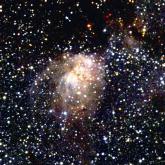 Atlas Image mosaic of IRAS 20306+4005, an object
in the Infrared Astronomical Satellite (IRAS) catalog of sources. Little is
known about this object, but it appears to be a region of current massive star
formation in the Galactic plane and near the Cygnus 0B2 stellar association.
This is the first known near-infrared image of this source. Infrared-bright
filaments of gas surround a young cluster of stars and young stellar objects
still embedded in their natal dusty molecular cloud.
A large patch of heavily-obscuring dust is seen to the
north of the nebula. 2MASS is ideal for investigating the nature of many IRAS
objects and other very young star-forming regions throughout the Galaxy.
Image mosaic by S. Van Dyk (IPAC). These data are included in the Second
Incremental Release!
(Field size 15.3´ × 17´. Image size 988 kb.)
Atlas Image mosaic of IRAS 20306+4005, an object
in the Infrared Astronomical Satellite (IRAS) catalog of sources. Little is
known about this object, but it appears to be a region of current massive star
formation in the Galactic plane and near the Cygnus 0B2 stellar association.
This is the first known near-infrared image of this source. Infrared-bright
filaments of gas surround a young cluster of stars and young stellar objects
still embedded in their natal dusty molecular cloud.
A large patch of heavily-obscuring dust is seen to the
north of the nebula. 2MASS is ideal for investigating the nature of many IRAS
objects and other very young star-forming regions throughout the Galaxy.
Image mosaic by S. Van Dyk (IPAC). These data are included in the Second
Incremental Release!
(Field size 15.3´ × 17´. Image size 988 kb.)
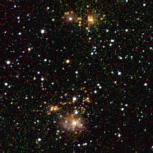 Atlas Image Mosaic of the high-mass star
formation region NS 14, also known as RAFGL 5216, BFS 57, and BIP 14. NS
14 is the region to the south in the image (BFS 56 is the smaller star
formation region to the north). First identified by Neckel & Staude (1984,
A&A, 131, 200) as a bipolar nebula at a distance of 2.3 kpc (7500 light
years), NS 14 is excited by four stars closely packed toward the brighter
center of the nebula, in an ultracompact HII region. A dense dust lane, or
torus, bisects the nebula, giving it a bipolar appearance. Howard, Pipher, &
Forrest (1998, ApJ, 509, 749) recently imaged the region in the near-infrared,
studying the stellar population of the cluster. Click
here to obtain a color-color diagram for NS 14, based on 2MASS photometry.
Image mosaic by S. Van Dyk (IPAC).
(Field size 7.0´ × 7.0´. Image size 211 kb.)
Atlas Image Mosaic of the high-mass star
formation region NS 14, also known as RAFGL 5216, BFS 57, and BIP 14. NS
14 is the region to the south in the image (BFS 56 is the smaller star
formation region to the north). First identified by Neckel & Staude (1984,
A&A, 131, 200) as a bipolar nebula at a distance of 2.3 kpc (7500 light
years), NS 14 is excited by four stars closely packed toward the brighter
center of the nebula, in an ultracompact HII region. A dense dust lane, or
torus, bisects the nebula, giving it a bipolar appearance. Howard, Pipher, &
Forrest (1998, ApJ, 509, 749) recently imaged the region in the near-infrared,
studying the stellar population of the cluster. Click
here to obtain a color-color diagram for NS 14, based on 2MASS photometry.
Image mosaic by S. Van Dyk (IPAC).
(Field size 7.0´ × 7.0´. Image size 211 kb.)
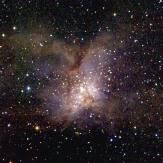 Atlas Image mosaic of the southern HII region
RCW 36. This region is associated with a molecular cloud in which
the star cluster, seen in the 2MASS image, is embedded. RCW 36 was previously
imaged in the near infrared (at 2 µm) by Braz & Epchtein (1982, A&A, 111,
91), where they resolved five sources. Many more sources are seen within
the dust and nebulosity of the region. To see a 2MASS color-color diagram
for these young stars (the inner 2´), click
here. The cluster appears to be behind at least 10 magnitudes of visual
extinction. Image mosaic by S. Van Dyk (IPAC).
(Field size 13.5´ × 13.5´. Image size 637 kb.)
Atlas Image mosaic of the southern HII region
RCW 36. This region is associated with a molecular cloud in which
the star cluster, seen in the 2MASS image, is embedded. RCW 36 was previously
imaged in the near infrared (at 2 µm) by Braz & Epchtein (1982, A&A, 111,
91), where they resolved five sources. Many more sources are seen within
the dust and nebulosity of the region. To see a 2MASS color-color diagram
for these young stars (the inner 2´), click
here. The cluster appears to be behind at least 10 magnitudes of visual
extinction. Image mosaic by S. Van Dyk (IPAC).
(Field size 13.5´ × 13.5´. Image size 637 kb.)
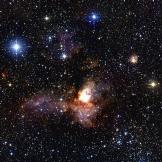 Atlas Image mosaic of the southern star-forming
region RCW 38. (N.B.: The mosaic is 3.7 Mb!) Zoom in on
the central cluster (IRS2; Frogel & Persson
1974, ApJ, 192, 351) in the inner 6´ × 6´ of the nebula;
a number of massive O stars are embedded within a dense, heavily obscuring
cloud. Ligori et al. (1994, MemSAI, 65, 815) find an age of ~2 Myr for the
stars in IRS2, showing that the star formation is very recent and still
ongoing. RCW 38 is at a distance of ~1.7 kpc (~5500 light years) from us,
near the famous Vela supernova remnant and the Gum nebula. As seen in the
2MASS near-infrared Image mosaic, the nebulosity associated with RCW 38 is
extensive across a large area, with dust lanes and patches running throughout.
Other, smaller obscured star-forming regions are nearby, with less-obscured
young, massive stars and associated reflection nebulae also in the field. A
high-resolution view in the near-infrared of IRS2 was recently
obtained by ESO's Very Large Telescope. Image mosaic by S. Van Dyk (IPAC).
(Field size 34.6´ × 33.1´. Image size 3.7 Mb!)
Atlas Image mosaic of the southern star-forming
region RCW 38. (N.B.: The mosaic is 3.7 Mb!) Zoom in on
the central cluster (IRS2; Frogel & Persson
1974, ApJ, 192, 351) in the inner 6´ × 6´ of the nebula;
a number of massive O stars are embedded within a dense, heavily obscuring
cloud. Ligori et al. (1994, MemSAI, 65, 815) find an age of ~2 Myr for the
stars in IRS2, showing that the star formation is very recent and still
ongoing. RCW 38 is at a distance of ~1.7 kpc (~5500 light years) from us,
near the famous Vela supernova remnant and the Gum nebula. As seen in the
2MASS near-infrared Image mosaic, the nebulosity associated with RCW 38 is
extensive across a large area, with dust lanes and patches running throughout.
Other, smaller obscured star-forming regions are nearby, with less-obscured
young, massive stars and associated reflection nebulae also in the field. A
high-resolution view in the near-infrared of IRS2 was recently
obtained by ESO's Very Large Telescope. Image mosaic by S. Van Dyk (IPAC).
(Field size 34.6´ × 33.1´. Image size 3.7 Mb!)
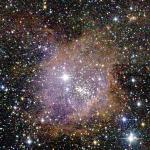 Atlas Image mosaic of Gum 25, aka RCW 40.
This is a bright southern HII, or ionized hydrogen, region, with a cluster of
hot, young, massive stars that are providing the ionizing ultraviolet photons.
Based on integrated photometry of the region and a distance of 1.7 kpc,
Copetti (2000, A&AS, 147, 93) estimates that the ionizing flux is at least
~1.58×1048 s-1, which is a factor of ~1300 smaller
than that from the giant HII region NGC 3603.
The 2MASS color-color and
color-magnitude diagrams show that the young
massive stars in Gum 25 are consistent with this distance and an extinction of
about 3.6 visual magnitudes. The nebula is clearly dusty, as can be seen in
the 2MASS image. A comparison with an optical image shows that much of the
ionizing star cluster is obscured by dust. Only in the 2MASS image is the
stellar populations in the cluster adequately revealed. Image mosaic by S.
Van Dyk (IPAC).
(Field size 15´ × 15´. Image size 3.7 Mb!)
Atlas Image mosaic of Gum 25, aka RCW 40.
This is a bright southern HII, or ionized hydrogen, region, with a cluster of
hot, young, massive stars that are providing the ionizing ultraviolet photons.
Based on integrated photometry of the region and a distance of 1.7 kpc,
Copetti (2000, A&AS, 147, 93) estimates that the ionizing flux is at least
~1.58×1048 s-1, which is a factor of ~1300 smaller
than that from the giant HII region NGC 3603.
The 2MASS color-color and
color-magnitude diagrams show that the young
massive stars in Gum 25 are consistent with this distance and an extinction of
about 3.6 visual magnitudes. The nebula is clearly dusty, as can be seen in
the 2MASS image. A comparison with an optical image shows that much of the
ionizing star cluster is obscured by dust. Only in the 2MASS image is the
stellar populations in the cluster adequately revealed. Image mosaic by S.
Van Dyk (IPAC).
(Field size 15´ × 15´. Image size 3.7 Mb!)
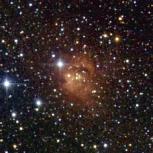 Atlas Image mosaic of the southern HII, or
ionized hydrogen, region RCW 46. This region lies at the eastern edge
of a recently-discovered large neutral hydrogen supershell, or giant void, with
radius 300 pc (980 light years; McClure-Griffiths et al. 2000, AJ, 119, 2828).
The supershell is in an interarm region near the Carina spiral arm in the
Milky Way, and the presence of molecular gas and HII regions along the
supershell indicate that star formation may have been initiated by the
supershell's expansion. Image mosaic by S. Van Dyk (IPAC).
(Field size 6.0´ × 6.0´. Image size 200 kb.)
Atlas Image mosaic of the southern HII, or
ionized hydrogen, region RCW 46. This region lies at the eastern edge
of a recently-discovered large neutral hydrogen supershell, or giant void, with
radius 300 pc (980 light years; McClure-Griffiths et al. 2000, AJ, 119, 2828).
The supershell is in an interarm region near the Carina spiral arm in the
Milky Way, and the presence of molecular gas and HII regions along the
supershell indicate that star formation may have been initiated by the
supershell's expansion. Image mosaic by S. Van Dyk (IPAC).
(Field size 6.0´ × 6.0´. Image size 200 kb.)
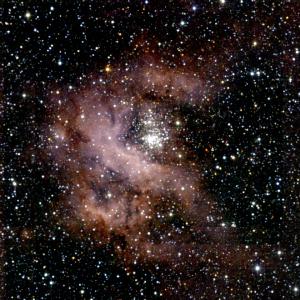 Atlas Image mosaic,
covering on the sky, of the HII region Gum 29,
aka RCW 49. This southern nebula of ionized hydrogen and other gases is
lit up by the radiation from the hot, young stars in the compact cluster
Westerlund 2, toward the center of the region. In the near-infrared we also
see the nebula as reflected starlight and excited molecular hydrogen in the
natal cloud from which the stars have very recently formed. Various gas
filaments and dusty tendrils can be seen in Gum 29. Also visible are various
holes in the nebula, the main one around the cluster and the Wolf-Rayet (W-R)
star WR 20a (the bright star to the northwest of the cluster), and another
prominent, yet smaller hole around the W-R star WR 20b (the bright star to
the southeast). These same holes, or shells, result from the vigorous winds
being blown by the stars, and can be seen also in the radio; the main hole
expands to the west to form an extended blister (Whiteoak & Uchida 1997, A&A,
317, 563). W-R stars represent the evolved phase for the most massive stars
in the Milky Way. Piatti, Bica, & Clariá (1997, A&AS, 127, 423), from
optical photometry, find that Westerlund 2 is behind about five magnitudes of
visual extinction, at a distance of 5.7 kpc (18600 light years), with an age
of 2 to 3 million years, which is very young (a number of infrared-bright knots
in Gum 29 indicate that star formation may still be ongoing!).
The 2MASS color-color and
color-magnitude diagrams are consistent with this distance and age
(although the larger distance estimate of 7.9 kpc is also reasonable; Moffat,
Shara, & Potter 1991, AJ, 102, 642), but with about 6.5 magnitudes of
extinction (note: the accuracy of 2MASS photometry for such dense star clusters
is compromised by crowding and blending effects). Image mosaic by S. Van Dyk
(IPAC).
(Field size 16´ × 16´. Image size 811 kb.)
Atlas Image mosaic,
covering on the sky, of the HII region Gum 29,
aka RCW 49. This southern nebula of ionized hydrogen and other gases is
lit up by the radiation from the hot, young stars in the compact cluster
Westerlund 2, toward the center of the region. In the near-infrared we also
see the nebula as reflected starlight and excited molecular hydrogen in the
natal cloud from which the stars have very recently formed. Various gas
filaments and dusty tendrils can be seen in Gum 29. Also visible are various
holes in the nebula, the main one around the cluster and the Wolf-Rayet (W-R)
star WR 20a (the bright star to the northwest of the cluster), and another
prominent, yet smaller hole around the W-R star WR 20b (the bright star to
the southeast). These same holes, or shells, result from the vigorous winds
being blown by the stars, and can be seen also in the radio; the main hole
expands to the west to form an extended blister (Whiteoak & Uchida 1997, A&A,
317, 563). W-R stars represent the evolved phase for the most massive stars
in the Milky Way. Piatti, Bica, & Clariá (1997, A&AS, 127, 423), from
optical photometry, find that Westerlund 2 is behind about five magnitudes of
visual extinction, at a distance of 5.7 kpc (18600 light years), with an age
of 2 to 3 million years, which is very young (a number of infrared-bright knots
in Gum 29 indicate that star formation may still be ongoing!).
The 2MASS color-color and
color-magnitude diagrams are consistent with this distance and age
(although the larger distance estimate of 7.9 kpc is also reasonable; Moffat,
Shara, & Potter 1991, AJ, 102, 642), but with about 6.5 magnitudes of
extinction (note: the accuracy of 2MASS photometry for such dense star clusters
is compromised by crowding and blending effects). Image mosaic by S. Van Dyk
(IPAC).
(Field size 16´ × 16´. Image size 811 kb.)
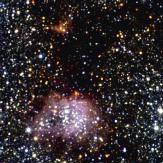 Atlas Image of the nebula RCW 87. Also known as IRAS 15015-5720 and
misclassified originally as a planetary nebula (Acker et al. 1987, A&AS, 71,
163), the nebula is more clearly an HII region (ionized nebula) and
young star cluster embedded in a dark dust cloud, situated less than 1°
from the Galactic Plane. The paucity of stars around the nebula, even in the
near-infrared, imply a high extinction toward this region. The nebula appears
to have a distinct boundary. The near-infrared emission from the nebula is
likely a combination of light from the bright young stars in the cluster
reflected by dust and possibly 2.12µ emission from the molecular hydrogen
gas from which the stars recently formed and still appear to be forming; along
the northwest edge of the nebula appears to be what could be an embedded young
stellar object. About 4.5´ to the northeast of the nebula's center
is another smaller embedded nebula, which could be the site of ongoing star
formation as well. Little is known about this probable recent star formation
site, which deserves further study. 2MASS is revealing many poorly-studied
or previously-unknown star formation regions, such as this one.
(Field size 8.3´ × 17.1´. Image size 560 kb.)
Atlas Image of the nebula RCW 87. Also known as IRAS 15015-5720 and
misclassified originally as a planetary nebula (Acker et al. 1987, A&AS, 71,
163), the nebula is more clearly an HII region (ionized nebula) and
young star cluster embedded in a dark dust cloud, situated less than 1°
from the Galactic Plane. The paucity of stars around the nebula, even in the
near-infrared, imply a high extinction toward this region. The nebula appears
to have a distinct boundary. The near-infrared emission from the nebula is
likely a combination of light from the bright young stars in the cluster
reflected by dust and possibly 2.12µ emission from the molecular hydrogen
gas from which the stars recently formed and still appear to be forming; along
the northwest edge of the nebula appears to be what could be an embedded young
stellar object. About 4.5´ to the northeast of the nebula's center
is another smaller embedded nebula, which could be the site of ongoing star
formation as well. Little is known about this probable recent star formation
site, which deserves further study. 2MASS is revealing many poorly-studied
or previously-unknown star formation regions, such as this one.
(Field size 8.3´ × 17.1´. Image size 560 kb.)
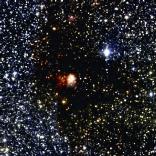 Atlas Image mosaic of the star-forming region
RCW 108. The infrared-bright nebula at the center of the region is a
cluster of
recently-formed stars still deeply embedded within their natal molecular cloud
(Straw et al. 1987, ApJ, 314, 283), only 1.5° below the Galactic Plane.
The cluster may have an age of only ~5×105 years.
Large amounts of dust obscuration are evident throughout the image around the
cluster, with at least 20 visual magnitudes of extinction toward the cluster
itself. A number of other young embedded sources are seen within the cloud
around the cluster. The molecular and dust cloud, at a distance of ~1.3 kpc
(4238 light years), is likely part of the much larger Ara OB stellar
association complex. It is possible that this young region was triggered into
formation by the energy input into the interstellar medium by the hot winds
from the young stars in the older nearby Ara OB1 association.
(Field size 12.3´ × 24.2´. Image size 1.0 Mb!)
Atlas Image mosaic of the star-forming region
RCW 108. The infrared-bright nebula at the center of the region is a
cluster of
recently-formed stars still deeply embedded within their natal molecular cloud
(Straw et al. 1987, ApJ, 314, 283), only 1.5° below the Galactic Plane.
The cluster may have an age of only ~5×105 years.
Large amounts of dust obscuration are evident throughout the image around the
cluster, with at least 20 visual magnitudes of extinction toward the cluster
itself. A number of other young embedded sources are seen within the cloud
around the cluster. The molecular and dust cloud, at a distance of ~1.3 kpc
(4238 light years), is likely part of the much larger Ara OB stellar
association complex. It is possible that this young region was triggered into
formation by the energy input into the interstellar medium by the hot winds
from the young stars in the older nearby Ara OB1 association.
(Field size 12.3´ × 24.2´. Image size 1.0 Mb!)
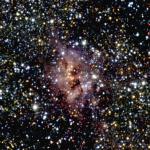 Atlas Image mosaic of the HII, or ionized
hydrogen, region RCW 122, aka BFS 65.
See the 2MASS
color-color and color-magnitude diagrams for
the embedded star cluster. Image mosaic by S. Van Dyk (IPAC).
(Field size 10´ × 10´. Image size 362 kb.)
Atlas Image mosaic of the HII, or ionized
hydrogen, region RCW 122, aka BFS 65.
See the 2MASS
color-color and color-magnitude diagrams for
the embedded star cluster. Image mosaic by S. Van Dyk (IPAC).
(Field size 10´ × 10´. Image size 362 kb.)
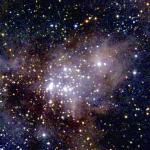 Atlas Image Mosaic of the H II region
W40. This region is part of a larger molecular cloud complex at a
distance of 600-700 pc (1960-2300 light years). A bright cluster of stars
is evident in the near-infrared 2MASS image which is not seen in the optical.
The previous near-IR imaging of W40 revealed only 7 infrared-bright sources,
all but one of which was associated with an optical star (Smith et al. 1985,
ApJ, 291, 571). In the 2MASS image, scores of stars are seen in the cluster,
among the dust and nebulosity of the molecular cloud in which the stars are
embedded. To see a 2MASS color-color diagram of the star cluster, click
here; the tracks are for dwarf and giant stars from
Bessell and Brett (1988, PASP, 100, 1134). The cluster of young stars is
behind at least 15 magnitudes of visual extinction. The full 2MASS mosaic
shows the cluster's overall environment. Image mosaic by S. Van Dyk (IPAC).
(Field size 27.0´ × 41.0´. Image size 3.8 Mb!)
Atlas Image Mosaic of the H II region
W40. This region is part of a larger molecular cloud complex at a
distance of 600-700 pc (1960-2300 light years). A bright cluster of stars
is evident in the near-infrared 2MASS image which is not seen in the optical.
The previous near-IR imaging of W40 revealed only 7 infrared-bright sources,
all but one of which was associated with an optical star (Smith et al. 1985,
ApJ, 291, 571). In the 2MASS image, scores of stars are seen in the cluster,
among the dust and nebulosity of the molecular cloud in which the stars are
embedded. To see a 2MASS color-color diagram of the star cluster, click
here; the tracks are for dwarf and giant stars from
Bessell and Brett (1988, PASP, 100, 1134). The cluster of young stars is
behind at least 15 magnitudes of visual extinction. The full 2MASS mosaic
shows the cluster's overall environment. Image mosaic by S. Van Dyk (IPAC).
(Field size 27.0´ × 41.0´. Image size 3.8 Mb!)
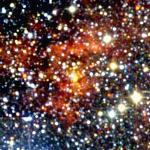 Atlas Image mosaic of W43, which is one of
the giant HII, or ionized hydrogen, regions in the Milky Way Galaxy. The gas
is ionized by a cluster of dozens of hot, young, massive stars, similar to the
conditions in NGC 3603. However, unlike NGC 3603,
W43 is completely obscured visually. 2MASS reveals the nebula and stars in
this image. 2MASS color-color and
color-magnitude diagrams, generated for an
area with radius 2.5´ centered on W43, show considerable variable
reddening in the field.
The distance to W43 derived from the radio is ~7 kpc
(22820 light years). Foreground stars appear appreciably less reddened, with
the cluster population having J-Ks~2.5 and redward. This
corresponds to visual extinction to the cluster stars of at least 15
magnitudes. Blum,
Damineli, & Conti (1999, AJ, 117, 1392) studied the central region of W43 in
the near-infrared and find that the central dense clustering contains several
very massive stars behind ~34 visual magnitudes of extinction. These are the
red stars between Ks~12 and 9 mag. In the 2MASS
image a number of objects can be seen at primarily Ks, with weak
H and J detections, which may be young stars embedded in their natal cloud on
the outskirts of W43. A scenario where the energy input from the central
cluster leads to the propagation of star formation elsewhere in the molecular
cloud is possible.
The bright star toward the southwest is the late-type pulsating variable
giant star AB Aql (it lies right at the edges of two 2MASS tiles and is not
associated with W43). 2MASS is
ideal for revealing recent star formation throughout the Galaxy.
Image mosaic by S. Van Dyk (IPAC).
(Field size 11´ × 11´. Image size 520 kb.)
Atlas Image mosaic of W43, which is one of
the giant HII, or ionized hydrogen, regions in the Milky Way Galaxy. The gas
is ionized by a cluster of dozens of hot, young, massive stars, similar to the
conditions in NGC 3603. However, unlike NGC 3603,
W43 is completely obscured visually. 2MASS reveals the nebula and stars in
this image. 2MASS color-color and
color-magnitude diagrams, generated for an
area with radius 2.5´ centered on W43, show considerable variable
reddening in the field.
The distance to W43 derived from the radio is ~7 kpc
(22820 light years). Foreground stars appear appreciably less reddened, with
the cluster population having J-Ks~2.5 and redward. This
corresponds to visual extinction to the cluster stars of at least 15
magnitudes. Blum,
Damineli, & Conti (1999, AJ, 117, 1392) studied the central region of W43 in
the near-infrared and find that the central dense clustering contains several
very massive stars behind ~34 visual magnitudes of extinction. These are the
red stars between Ks~12 and 9 mag. In the 2MASS
image a number of objects can be seen at primarily Ks, with weak
H and J detections, which may be young stars embedded in their natal cloud on
the outskirts of W43. A scenario where the energy input from the central
cluster leads to the propagation of star formation elsewhere in the molecular
cloud is possible.
The bright star toward the southwest is the late-type pulsating variable
giant star AB Aql (it lies right at the edges of two 2MASS tiles and is not
associated with W43). 2MASS is
ideal for revealing recent star formation throughout the Galaxy.
Image mosaic by S. Van Dyk (IPAC).
(Field size 11´ × 11´. Image size 520 kb.)
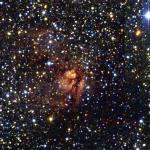 Atlas Image Mosaic of the HII region W48.
There is no optical counterpart to this radio emission region, due to its
proximity to the Galactic plane, its distance of 3.4 kpc (11084 light years),
and about 23 visual magnitudes of extinction
(Vallee & MacLeod 1990, ApJ, 358, 183), but it is obvious in the 2MASS
near-infrared image. The center of W48 is still heavily obscured, with dark
dust lanes running through it. W48 is at the edge of more extended molecular
gas cloud. The dusty nebula appears to be the site of ongoing massive star
formation. Image mosaic by S. Van Dyk (IPAC).
(Field size 10.0´ × 10.0´. Image size 388 kb.)
Atlas Image Mosaic of the HII region W48.
There is no optical counterpart to this radio emission region, due to its
proximity to the Galactic plane, its distance of 3.4 kpc (11084 light years),
and about 23 visual magnitudes of extinction
(Vallee & MacLeod 1990, ApJ, 358, 183), but it is obvious in the 2MASS
near-infrared image. The center of W48 is still heavily obscured, with dark
dust lanes running through it. W48 is at the edge of more extended molecular
gas cloud. The dusty nebula appears to be the site of ongoing massive star
formation. Image mosaic by S. Van Dyk (IPAC).
(Field size 10.0´ × 10.0´. Image size 388 kb.)
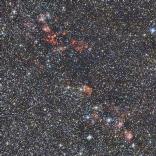 Atlas Image mosaic showing one of the most
luminous star-forming complexes in the Galaxy, W51. The environment here is
rich in newly-forming massive stars,compact and extended H II regions, and
molecular clouds, including the
Ks-bright, arc-like region, G49.5-0.4, to the northeast.
The extended emission in Ks (2.17 µm) is thermal emission from
ionized gas associated with the H II regions (Goldader & Wynn-Williams 1994,
ApJ, 433, 164). W51 is
along the Sagittarius arm in our Galaxy at about 7.5 kpc.
The visual extinction in this
region is very high, from AV ~ 25 to 1000! Hot, main-sequence OB
stars can be detected in these near-IR colors, which are consistent with the
distance and extintion to W51 and are likely members. A number of embedded
massive stars probably comprise the famous IRS sources
(Wynn-Williams, Becklin, & Neugebauer 1974, ApJ, 187, 473) in G49.5-0.4.
The supernova remnant W51C is not detected in this image.
(Field size 1.18° × 0.72°. Image size 488 kB.)
Atlas Image mosaic showing one of the most
luminous star-forming complexes in the Galaxy, W51. The environment here is
rich in newly-forming massive stars,compact and extended H II regions, and
molecular clouds, including the
Ks-bright, arc-like region, G49.5-0.4, to the northeast.
The extended emission in Ks (2.17 µm) is thermal emission from
ionized gas associated with the H II regions (Goldader & Wynn-Williams 1994,
ApJ, 433, 164). W51 is
along the Sagittarius arm in our Galaxy at about 7.5 kpc.
The visual extinction in this
region is very high, from AV ~ 25 to 1000! Hot, main-sequence OB
stars can be detected in these near-IR colors, which are consistent with the
distance and extintion to W51 and are likely members. A number of embedded
massive stars probably comprise the famous IRS sources
(Wynn-Williams, Becklin, & Neugebauer 1974, ApJ, 187, 473) in G49.5-0.4.
The supernova remnant W51C is not detected in this image.
(Field size 1.18° × 0.72°. Image size 488 kB.)
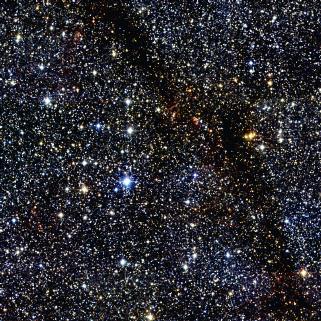 The HII region Sharpless 82.
(Field size 0.49° × 0.74°. Image size 4.9 Mb!)
The HII region Sharpless 82.
(Field size 0.49° × 0.74°. Image size 4.9 Mb!)
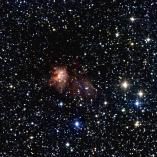
The Sharpless 88 (S88) molecular cloud. S88 is a diffuse H II
region that lies about 10´ northwest of the central part of this image.
The small nebula shown here is the compact H II region S88-B. S88-A,
another luminous star-forming site in this molecular cloud, is faintly seen
as a nebulous feature about 2´ southwest of S88-B.
The larger-scale molecular cloud associated with these star-forming sites
obscures many of the background field stars, which accounts for the
paucity of stars near the center of the image.
(Field size 9.5´ × 15´. Image size 542 kB.)
For a recent paper on the extinction associated with S88-B, see
Goetz et al.
(1999).
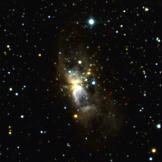
Sharpless 106 (S106), a bipolar HII region. The bipolar structure of this
nebula has been attributed to a torus of molecular gas and dust running
east-west that surrounds the central massive star. A cluster of lower
mass stellar objects are apparent in the vicinity of the nebula.
(Field size 13´ × 8.3´. Image size 279 kB.)
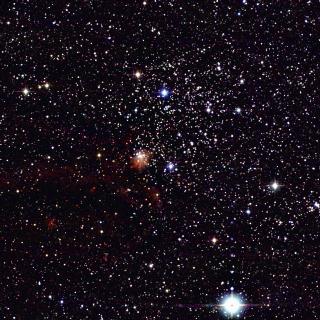 The HII region Sharpless 155.
(Field size 26.7´ × 26.7´. Image size 2.3 Mb!)
The HII region Sharpless 155.
(Field size 26.7´ × 26.7´. Image size 2.3 Mb!)
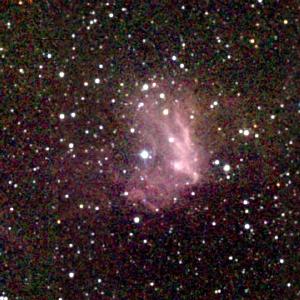 Atlas Image mosaic of the ionized hydrogen, or
"HII", region NGC 1491, aka Sharpless 206 and RAFGL 5111. NGC 1491 is
an example of a "blister" type of H II region, where, in this case, the adjacent
dense molecular cloud is being excited by the hot, young O6-type star, BD
+50°886 (aka Sh 2-206 IRS 1), seen toward the center of the 2MASS image
(Mookerjea et al. 1999, ApJ, 522, 285). The excited molecular gas emits
primarily in the 2MASS Ks band, which results in the
pinkish/purplish color of the filamentary nebulosity, seen primarily to the
west of the exciting star. The star and the region are at a distance of
3.3 kpc (10760 light years; Snell et al. 1990, ApJ, 352, 139) from us.
Previous near-infrared mapping was done by Picmis & Mampaso (1991, MNRAS, 249,
385), but at much lower resolution: they detect the central star and the two
stars, immediately northeast and northwest of BD+50°886, which they
identify as early B-type stars. They also estimate that the stars are seen
through about four visual magnitudes of extinction.
(Field size 9´ × 9´. Image size 323 kb.)
Atlas Image mosaic of the ionized hydrogen, or
"HII", region NGC 1491, aka Sharpless 206 and RAFGL 5111. NGC 1491 is
an example of a "blister" type of H II region, where, in this case, the adjacent
dense molecular cloud is being excited by the hot, young O6-type star, BD
+50°886 (aka Sh 2-206 IRS 1), seen toward the center of the 2MASS image
(Mookerjea et al. 1999, ApJ, 522, 285). The excited molecular gas emits
primarily in the 2MASS Ks band, which results in the
pinkish/purplish color of the filamentary nebulosity, seen primarily to the
west of the exciting star. The star and the region are at a distance of
3.3 kpc (10760 light years; Snell et al. 1990, ApJ, 352, 139) from us.
Previous near-infrared mapping was done by Picmis & Mampaso (1991, MNRAS, 249,
385), but at much lower resolution: they detect the central star and the two
stars, immediately northeast and northwest of BD+50°886, which they
identify as early B-type stars. They also estimate that the stars are seen
through about four visual magnitudes of extinction.
(Field size 9´ × 9´. Image size 323 kb.)
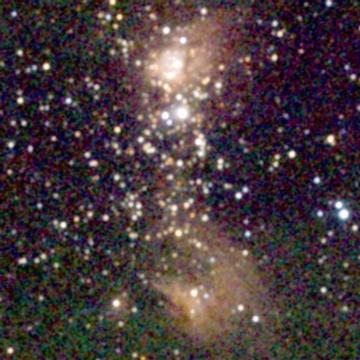 The HII region Sharpless 235.
(Field size 6.0´ × 8.3´. Image size 228 kb.)
The HII region Sharpless 235.
(Field size 6.0´ × 8.3´. Image size 228 kb.)
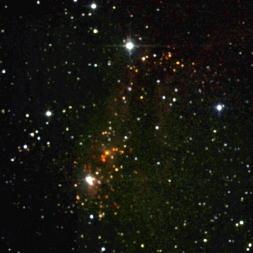 The HII region Sharpless 242.
(Field size 8.0´ × 8.0´. Image size 226 kb.)
The HII region Sharpless 242.
(Field size 8.0´ × 8.0´. Image size 226 kb.)
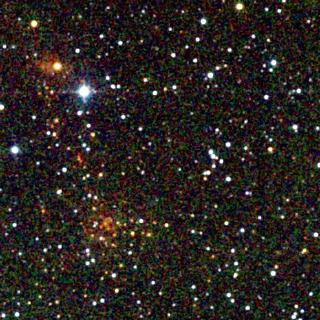 The HII region Sharpless 247.
(Field size 8.2´ × 8.2´. Image size 313 kb.)
The HII region Sharpless 247.
(Field size 8.2´ × 8.2´. Image size 313 kb.)
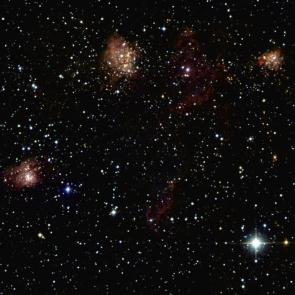 Atlas Image Mosaic of the H II region complex
Sharpless 252. Optically, this complex is dominated by HD 42088,
the blue star east of center in the mosaic, at the heart of the nebula NGC
2175. H II regions are areas of ionized gas, where electrons have been
stripped away from once-neutral hydrogen (H) and other atoms, by the intense
ultraviolet radiation from hot, young stars. In the near-infrared we see the
young, massive embedded and infrared-bright stars, forming in the other parts
of the complex: the bright clusters Sh 252A in the west, Sh 252C north of
center in the mosaic, and Sh 252E to the east. The blue star HD 252325
excites the gas that is Sh 252B (between A and C). Faint, extended
Ks-bright emission is seen throughout the center of the mosaic.
These data are part of the online Spring 1999 Incremental data release.
(Field size 9.8´ × 9.8´. Image size 330 kB.)
Atlas Image Mosaic of the H II region complex
Sharpless 252. Optically, this complex is dominated by HD 42088,
the blue star east of center in the mosaic, at the heart of the nebula NGC
2175. H II regions are areas of ionized gas, where electrons have been
stripped away from once-neutral hydrogen (H) and other atoms, by the intense
ultraviolet radiation from hot, young stars. In the near-infrared we see the
young, massive embedded and infrared-bright stars, forming in the other parts
of the complex: the bright clusters Sh 252A in the west, Sh 252C north of
center in the mosaic, and Sh 252E to the east. The blue star HD 252325
excites the gas that is Sh 252B (between A and C). Faint, extended
Ks-bright emission is seen throughout the center of the mosaic.
These data are part of the online Spring 1999 Incremental data release.
(Field size 9.8´ × 9.8´. Image size 330 kB.)
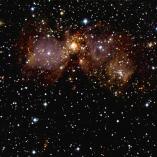 The galactic HII regions Sharpless 254 through 258. The molecular cloud
associated with Sharpless 254 through 258
is an active, ongoing star formation location. This cloud is part of the
larger Gem OB1 complex. These regions of ionized gas are at a distance of 2.5
kpc (8150 light years) from us and are located near the Galactic anticenter.
These regions were previously imaged at K-band by Hodapp (1994, ApJS, 94, 615).
A complex of nebulosity is seen in the 2MASS image.
The bright blue, hot ionizing stars in the HII regions are surrounded
by bluish reflection nebulae (dust scattering the stars' blue light). Also
seen throughout the field and, particularly, in the central cluster of
Sharpless 255 are a large number of infrared bright, reddish, presumably
high-mass young stars and stellar objects, still embedded in the cloud. A
number of OH and H20 masers are also associated with these regions,
indicating recent and ongoing star formation.
These data are part of the Spring 1999 data release.
Image mosaic by S. Van Dyk (IPAC). (Field size 21.5´ × 14.5´.
Image size 960 kB!)
The galactic HII regions Sharpless 254 through 258. The molecular cloud
associated with Sharpless 254 through 258
is an active, ongoing star formation location. This cloud is part of the
larger Gem OB1 complex. These regions of ionized gas are at a distance of 2.5
kpc (8150 light years) from us and are located near the Galactic anticenter.
These regions were previously imaged at K-band by Hodapp (1994, ApJS, 94, 615).
A complex of nebulosity is seen in the 2MASS image.
The bright blue, hot ionizing stars in the HII regions are surrounded
by bluish reflection nebulae (dust scattering the stars' blue light). Also
seen throughout the field and, particularly, in the central cluster of
Sharpless 255 are a large number of infrared bright, reddish, presumably
high-mass young stars and stellar objects, still embedded in the cloud. A
number of OH and H20 masers are also associated with these regions,
indicating recent and ongoing star formation.
These data are part of the Spring 1999 data release.
Image mosaic by S. Van Dyk (IPAC). (Field size 21.5´ × 14.5´.
Image size 960 kB!)
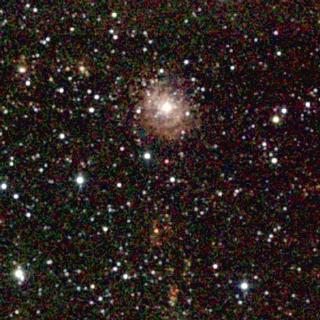 The HII region Sharpless 266.
(Field size 8.2´ × 11.7´. Image size 405 kb.)
The HII region Sharpless 266.
(Field size 8.2´ × 11.7´. Image size 405 kb.)
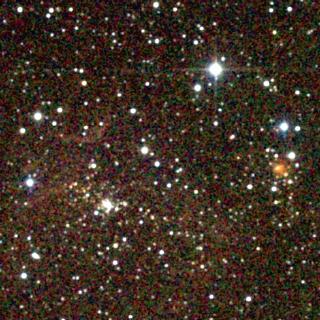 The HII region Sharpless 267.
(Field size 8.2´ × 8.2´. Image size 299 kb.)
The HII region Sharpless 267.
(Field size 8.2´ × 8.2´. Image size 299 kb.)
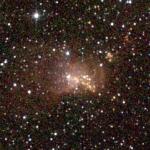 Atlas Image mosaic of Sharpless 269.
See the 2MASS
color-color and color-magnitude diagrams.
Atlas Image mosaic of Sharpless 269.
See the 2MASS
color-color and color-magnitude diagrams.
(Field size 8´ × 8´. Image size 262 kb.)
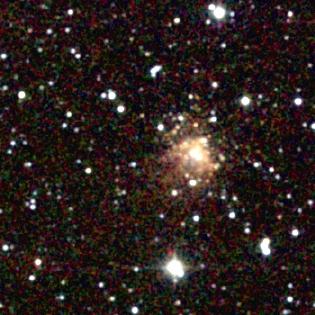 The HII region Sharpless 270.
(Field size 5.8´ × 5.8´. Image size 167 kb.)
The HII region Sharpless 270.
(Field size 5.8´ × 5.8´. Image size 167 kb.)
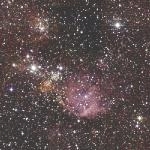 Atlas Image mosaic,
covering on the sky of Sharpless 311.
This nebula
is an HII (or ionized hydrogen) region. Within the region is the bright, hot
emission-line star HD 64315. Associated with Sharpless 311 is the open star
cluster NGC 2467, which is the assumed heart of the much larger Puppis I OB
stellar association. Feinstein & Vasquez (1989, A&AS, 77, 321), based on
optical photometry of the cluster, emphasize that the stars in NGC 2467 are
not all of the same distance, that it is not a true open cluster; they
conclude that one star group has a distance consistent with Puppis I, and
another is beyond even the more distant Puppis II association. Previous
near-infrared studies of NGC 2467 has
consisted only of integrated photometry (Persi et al. 1987, A&AS, 70, 437).
2MASS clearly resolves several groupings of stars more heavily obscured in
the optical. The 2MASS color-color and
color-magnitude diagrams indicate a
number of populations in the field. The cyan, blue, and green lines (stellar
tracks) on the latter diagram show several young stellar groups at
different distances and experiencing different amounts of reddening; the green
track represents the two obvious subclusters in the east and northeast, at
~6300 kpc and extinction of 5.5 visual magnitudes (beyond Pup II). (The
largest grouping on the latter diagram are foreground stars.) Other,
more reddened stars are also in this field near the Galactic plane.
Image mosaic by S. Van Dyk (IPAC).
(Field size 20´ × 20´. Image size 1.4 Mb!)
Atlas Image mosaic,
covering on the sky of Sharpless 311.
This nebula
is an HII (or ionized hydrogen) region. Within the region is the bright, hot
emission-line star HD 64315. Associated with Sharpless 311 is the open star
cluster NGC 2467, which is the assumed heart of the much larger Puppis I OB
stellar association. Feinstein & Vasquez (1989, A&AS, 77, 321), based on
optical photometry of the cluster, emphasize that the stars in NGC 2467 are
not all of the same distance, that it is not a true open cluster; they
conclude that one star group has a distance consistent with Puppis I, and
another is beyond even the more distant Puppis II association. Previous
near-infrared studies of NGC 2467 has
consisted only of integrated photometry (Persi et al. 1987, A&AS, 70, 437).
2MASS clearly resolves several groupings of stars more heavily obscured in
the optical. The 2MASS color-color and
color-magnitude diagrams indicate a
number of populations in the field. The cyan, blue, and green lines (stellar
tracks) on the latter diagram show several young stellar groups at
different distances and experiencing different amounts of reddening; the green
track represents the two obvious subclusters in the east and northeast, at
~6300 kpc and extinction of 5.5 visual magnitudes (beyond Pup II). (The
largest grouping on the latter diagram are foreground stars.) Other,
more reddened stars are also in this field near the Galactic plane.
Image mosaic by S. Van Dyk (IPAC).
(Field size 20´ × 20´. Image size 1.4 Mb!)
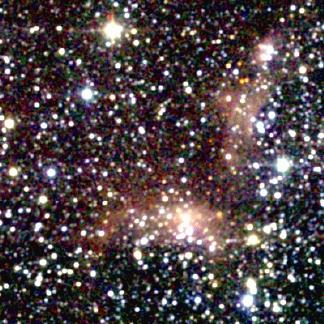 The HII region IC 4954.
(Field size 6.7´ × 10.8´. Image size 334 kb.)
The HII region IC 4954.
(Field size 6.7´ × 10.8´. Image size 334 kb.)
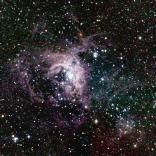 Atlas Image mosaic of the Tarantula, or 30 Doradus,
Nebula (also known as NGC 2070). This nebula, in the
Large Magellanic Cloud,
is the closest example to us of a giant ionized hydrogen (H II) region,
covering several hundred parsecs in diameter. The closest analog in our
Milky Way Galaxy is the H II region NGC 3603. 30 Doradus
serves as a "Rosetta Stone" for massive starbursts of
this kind in galaxies at larger distances from us.
Clusters of hundreds of young, massive O and B stars, particularly the
dense central "super star" cluster, R136, provide the
ultraviolet photons which ionize and photoevaporate the large filamentary
cloud. A number of
other stellar populations, including red supergiants and Wolf-Rayet stars,
coexist in 30 Doradus. Detailed studies in the optical of the nebula and its
stellar contents shows a complex history of recent star formation. In the
near-infrared, Rubio et al. (1998, AJ, 116, 1708) point out that
pre-main-sequence objects are also found, particularly along the
Ks-bright molecular hydrogen (H2) line-emitting
filaments in the nebula's periphery, which can be seen in the 2MASS image.
What emerges is a scenario
of new generations of stars triggered by the energy input from the massive
stellar clusters, which is likely a characteristic picture for star-forming
regions of this scale in galaxies.
Image mosaic by E. Kopan (IPAC).
These data are included in the Second Incremental Release!
(Field size 14.3´ × 14.3´. Image size 782 kB.)
Atlas Image mosaic of the Tarantula, or 30 Doradus,
Nebula (also known as NGC 2070). This nebula, in the
Large Magellanic Cloud,
is the closest example to us of a giant ionized hydrogen (H II) region,
covering several hundred parsecs in diameter. The closest analog in our
Milky Way Galaxy is the H II region NGC 3603. 30 Doradus
serves as a "Rosetta Stone" for massive starbursts of
this kind in galaxies at larger distances from us.
Clusters of hundreds of young, massive O and B stars, particularly the
dense central "super star" cluster, R136, provide the
ultraviolet photons which ionize and photoevaporate the large filamentary
cloud. A number of
other stellar populations, including red supergiants and Wolf-Rayet stars,
coexist in 30 Doradus. Detailed studies in the optical of the nebula and its
stellar contents shows a complex history of recent star formation. In the
near-infrared, Rubio et al. (1998, AJ, 116, 1708) point out that
pre-main-sequence objects are also found, particularly along the
Ks-bright molecular hydrogen (H2) line-emitting
filaments in the nebula's periphery, which can be seen in the 2MASS image.
What emerges is a scenario
of new generations of stars triggered by the energy input from the massive
stellar clusters, which is likely a characteristic picture for star-forming
regions of this scale in galaxies.
Image mosaic by E. Kopan (IPAC).
These data are included in the Second Incremental Release!
(Field size 14.3´ × 14.3´. Image size 782 kB.)
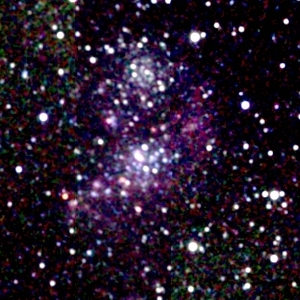 Atlas Image mosaic of NGC 346. This is the
brightest open stellar cluster and HII (or ionized hydrogen) region
in the Small Magellanic Cloud
(SMC), one of the dwarf satellite galaxies to our own Milky Way Galaxy. The
SMC is at a distance from us of ~63 kpc (205,400 light years). In the optical
this cluster is highlighted by many hot, young, massive stars (Massey, Parker,
& Garmany 1989, AJ, 98, 1305). In the near-infrared the most prominent stars
are a much older, underlying population of red giant stars. Also revealed are
several dust-obscured stars. These populations can be seen in the 2MASS
color-color and
color-magnitude diagrams. On the latter diagram in green are shown
isochrones (for the appropriate low metallicity, or heavy element abundance,
of the SMC) for 4 Myr, 15 Myr, and 10 Gyr. The bluer, hot,
young population is faintly detected by 2MASS, but a large ensemble of red
giants with ages of about 10 billion years (not a rigorous fit) is prevalent.
(The three brightest stars seen in the diagrams are likely Galactic foreground
stars.)
The bright red star to the southeast in the 2MASS image has a
Ks magnitude of 12.15 and color J-Ks=2.95, and is likely
a dust-obscured asymptotic giant branch star. Reflected starlight and
likely molecular hydrogen emission from the nebula can also be seen in the
2MASS image. Image mosaic by S. Van Dyk (IPAC).
(Field size 5´ × 5´. Image size 135 kB.)
Atlas Image mosaic of NGC 346. This is the
brightest open stellar cluster and HII (or ionized hydrogen) region
in the Small Magellanic Cloud
(SMC), one of the dwarf satellite galaxies to our own Milky Way Galaxy. The
SMC is at a distance from us of ~63 kpc (205,400 light years). In the optical
this cluster is highlighted by many hot, young, massive stars (Massey, Parker,
& Garmany 1989, AJ, 98, 1305). In the near-infrared the most prominent stars
are a much older, underlying population of red giant stars. Also revealed are
several dust-obscured stars. These populations can be seen in the 2MASS
color-color and
color-magnitude diagrams. On the latter diagram in green are shown
isochrones (for the appropriate low metallicity, or heavy element abundance,
of the SMC) for 4 Myr, 15 Myr, and 10 Gyr. The bluer, hot,
young population is faintly detected by 2MASS, but a large ensemble of red
giants with ages of about 10 billion years (not a rigorous fit) is prevalent.
(The three brightest stars seen in the diagrams are likely Galactic foreground
stars.)
The bright red star to the southeast in the 2MASS image has a
Ks magnitude of 12.15 and color J-Ks=2.95, and is likely
a dust-obscured asymptotic giant branch star. Reflected starlight and
likely molecular hydrogen emission from the nebula can also be seen in the
2MASS image. Image mosaic by S. Van Dyk (IPAC).
(Field size 5´ × 5´. Image size 135 kB.)
(Some captions provided by John Carpenter [Caltech].)
Return to 2MASS Image Gallery Homepage